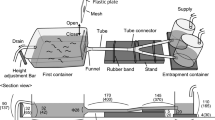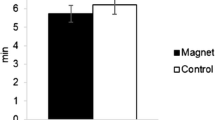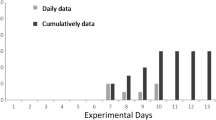Abstract
Magnetosensitivity in a nosmic Japanese eel Anguilla japonica was examined by conditioning and electrocardiography. Five eels from a freshwater farm in Kagoshima, Japan, were made anosmic by injection of boiling petroleum jelly (130–140°C) into the nasal cavity, a technique widely used in studies on olfaction and olfaction-related behavior of eels. Another five eels were not injected with boiling petroleum jelly and served as controls. Conditioning consisted of exposure of eels to an imposed magnetic field of 192 473 nT. After complete conditioning of the eels, the imposed magnetic field was reduced from 192 473 nT to 12 663 nT during the tests. The control eels showed a significant conditioned response (i.e. slowing of the heart beat) to the magnetic field after one sete of conditioning runs. The anosmic eels did not respond to the magnetic field, presumably due to damage of the olfactory organ from the jelly injection. The results suggest that Japanese eels have a magnetosensitive organ in or around the nares. At 1 month after the anosmia treatment, there was no visible trauma to the olfactory lamellae of anosmic eels.
Similar content being viewed by others
References
Keeton WT. The mystery of pigeon homing. Sci. Am. 1974a; 231: 96–107.
Keeton WT. The orientational and navigational basis of homing in birds. In: Lehrman DS, Rosenblath JS, Hinde RA. Shaw ES (eds). Advances in the Study of Behavior, Vol. 5. Academic Press, New York. 1974b; 48–132.
Papi F, Fiore L, Fiaschi V, Benvenuti S. Olfaction and homing in pigeons. Monitore Zool. Ital. (N.S.) 1972; 6: 85–95.
Papi F, Fiore L, Fiaschi V, Benvenuti S. An experiment for testing the hypothesis of olfactory navigation of homing pigeons. J. Comp. Physiol. 1973; 83: 93–102.
Able KP. The debate over olfactory navigation by homing pigeions. J. Exp. Biol. 1996; 199: 121–124.
Quinn TP. Evidence for celestial and magnetic compass orientation in lake migrating sockeye salmon fry. J. Comp. Physiol. 1980; 137: 243–248.
Sakaki Y, Motomiya T. Possible mechanism of biomagnetic sense organ extracted from sockey salmon. IEEE Trans. Magn. 1990; 26: 1554–1556.
Souza JJ, Poluhowich JJ, Guerra RJ. Orientation responses of American eels, Anguilla rostrata, to varying magnetic fields. Comp. Biochem. Physiol. 1988; 90A: 57–61.
Lohmann KJ, Lohmann CMF. Acquisition of magnetic directional preference in hatuchling loggerhead sea turtles. J. Exp. Biol. 1994; 190: 1–8.
Tesch FW, Westerberg H, Karlsson L. Tracking studies on migrating silver eels in the Central Baltic. Meeresforschung 1991; 33: 183–196.
Westin L. Orientation mechanisms in migrating European silver eels (Anguilla anguilla): temperature and olfaction. Mar. Biol. 1990; 106: 175–179.
Barbin GP, Parker SJ, McCleave JD. Olfactory clues play a critical role in the estuarine migration of silver-phase American eels. Env. Biol. Fish 1998; 53: 283–291.
Walker MM, Diebel CE, Haugh CV, Pankhurst PM, Montgomery JC, Green CR. Structure and function of the vertebrate magnetic sense. Nature 1997; 390: 371–376.
Keefe M. Chemically mediated avoidance behavior in wild brook trout, Salvelinus fontinalis: the response to familiar and unfamiliar predaceous fishes and the influence of fish diet. Can. J. Zool. 1992; 70: 288–292.
Nishi T, Kawamura G, Matsumoto K. Magnetic sense in the Japanese eel Anguilla japonica as determined by conditioning and electrocardiography. J. Exp. Biol. 2004; 207: 2965–2970.
Olsen KH, Jarvi JT, Mayer I, Peterson E, Kroon F. Spawning behavior and sex hormone levels in adult and precocious brown trout (Salmo trutta L.) males and the effect of anosmia. Chemoecology 1998; 8: 9–17.
Barbin GP. The role of olfaction in homing and estuarine migratory behavior of yellow-phase American eels. Can. J. Fish. Aquat. Sci. 1998; 55: 564–575.
Jackson JD. Classical Electrodynamics, 3rd edn. John Wiley & Sons Inc., New York, 1999.
Kawamura G, Shibata A, Yonemori T. Response of teleosts to the plane of polarized light as determined by the heart beat rate. Nippon Suisan Gakkaishi 1981; 47: 727–729.
Diebel CE, Proksch R, Green CR, Neilson P, Walker MM. Magnetite defines a vertebrate magnetoreceptor. Nature 2000; 406: 299–302.
Author information
Authors and Affiliations
Corresponding author
Rights and permissions
About this article
Cite this article
Nishi, T., Kawamura, G. & Sannomiya, S. Anosmic Japanese eel Anguilla japonica can no longer detect magnetic fields. Fish Sci 71, 101–106 (2005). https://doi.org/10.1111/j.1444-2906.2005.00936.x
Received:
Accepted:
Issue Date:
DOI: https://doi.org/10.1111/j.1444-2906.2005.00936.x




